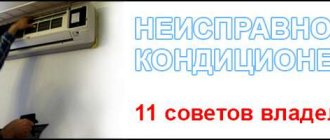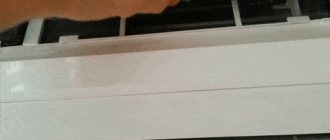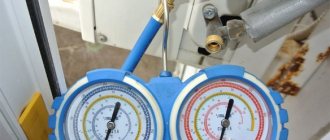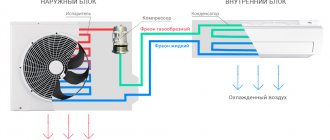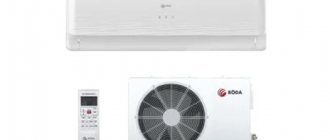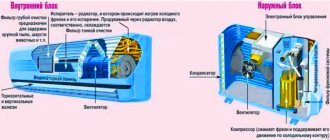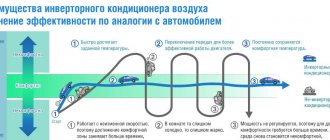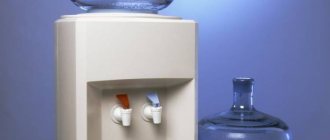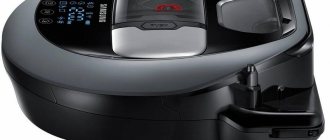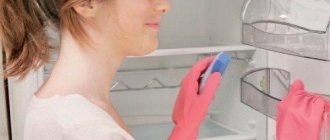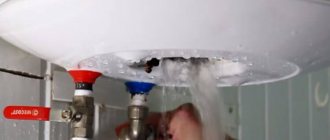No. 1. Why does the air conditioner need to be cleaned?
This question may seem stupid to some. Like, why is there dirt in the air conditioner if the air in the apartment is clean? The thing is that home air, alas, is not as clean as we think. The indoor unit of the air conditioner constantly sucks air from the apartment, cools it and blows it back out. Additionally, the air is purified from dust and small mechanical particles. This is animal hair, hairs, lint, plant particles brought on clothes from the street, etc. All this settles on coarse and fine filters. As a result, we get a number of adverse consequences:
- complicated passage of air through reduced holes in a clogged filter, and, as a result , a decrease in the efficiency of the air conditioner and an increase in the load on the parts of the device, which leads to its rapid failure;
- the heat exchanger with freon may begin to overheat due to accumulated dirt, the load on the compressor will increase, which will also lead to accelerated wear ;
- leaves, dust, sand, fluff get into the external unit, stick to the fan, compressor and condenser, as a result, the normal heat exchange process is disrupted, energy costs increase;
- The most dangerous thing is not even a breakdown or complete failure of the climate control equipment, but a negative impact on health. The accumulation of dust and organic particles on the filter, coupled with high humidity, is an ideal breeding ground for fungus, mold and dust mites. The most dangerous microorganism that can settle in an air conditioner and spread throughout the apartment is legionella, which can cause lung disease. People with good health and strong immunity will not immediately feel the pathogenic effects of their own air conditioner - asthmatics and people with problems with the respiratory and cardiovascular systems will be the first to suffer. You don’t have to be a doctor to imagine what harm fungal spores that have matured in the air conditioner flying around your apartment can cause;
- An unpleasant odor is the most harmless consequence of an untimely cleaned air conditioner.
Cleaning your air conditioner yourself is not as difficult as it might seem. Some parts can be cleaned with improvised means, others require a more specific approach and the purchase of special tools and cleaning products, but this is much cheaper than regularly calling in specialists.
Preparing the system for summer or winter
Caring for an air conditioner or split system in an apartment includes taking measures to prepare for the change of season. Regardless of whether the model is adapted for winter use or not, there are some temperature restrictions. Turning on climate control equipment at a temperature below the permissible temperature may result in liquid leakage and subsequent icing of the external unit.
Before the onset of cold weather, you must clean your home air conditioner and dry the entire system. Modern models have a special “FAN” function (the name may be different).
In preparation for the warm season, the internal module of the split system or air conditioner must be cleaned again. During downtime, fine house dust will certainly collect inside the case, so you need to wash the air filters and the fan, and, if necessary, the evaporator.
Caring for climate control equipment in an apartment or office increases its efficiency and increases the service life of the air conditioner. The technical design of air conditioning systems is simple, which is why many users prefer to carry out cleaning activities on their own.
No. 2. How often should you clean your air conditioner?
There is no clear rule regarding how often the air conditioner should be cleaned - it all depends on many factors. For example, residents of the upper floors of multi-story buildings can clean much less often than their neighbors on the lower floors, because there is less dust at the top. But less often does not mean never. Residents of houses located near busy highways, industrial enterprises, and construction sites will have to clean much more often.
The external unit needs cleaning less often than the internal one . As a rule, one cleaning per year is enough, but there are many exceptions to this rule:
- if the house is located in an area with a dense planting of poplars and other plants that produce a lot of fluff when flowering, then cleaning will have to be done more often, since the fluff can completely clog the filter of the outdoor unit of the split system in a short period of time;
- if you live above the 7-8 floor, then it is allowed to clean it once every couple of years;
- The external unit, located above the 12th floor, can be cleaned every few years.
The indoor unit needs to be cleaned much more often. Ideally, when you do a complete cleaning of the apartment, you should clean the coarse filter. It is located directly under the external panel of the air conditioner. This rule applies to those who actively use climate control equipment. It is better to carry out deep cleaning of the indoor unit of the air conditioner twice a year:
- in the spring, before actively using the system in the summer heat;
- in the fall, after the summer period and before working in the winter in the heating system;
- unscheduled if characteristic noise, smell and other signs appear, which will be described below.
Deep cleaning means processing not only the coarse filter, but also washing or replacing fine filters and processing the heat exchanger.
Preventative cleaning is carried out before anything happens to the air conditioner. It also happens that the system itself begins to show signs that it needs a quality wash:
- the appearance of specific noise when the device is turned on;
- the appearance of a rotten and damp smell;
- leakage from the indoor unit;
- increased energy consumption with the same or reduced cooling capacity;
- gurgling and popping sounds indicate problems with the drainage system;
- tapping in the external unit during operation.
If you keep your air conditioner clean, the equipment will last at least 10 years and will not pollute your air.
Why you need to contact specialists
There are many organizations providing service and repair of climate control equipment. Qualified specialists carry out cleaning of air conditioners and routine technical inspection of systems, including diagnostics and repair work. A common practice among the population is to order a cleaning service as an illustrative example. Despite the general rules, devices may differ structurally from each other.
It is possible to clean a split system or monoblock on your own, but servicing air conditioning equipment does not end there. During operation, the volume of refrigerant is reduced annually by approximately 7%. For stable operation of the air conditioner, its volume must be replenished annually; for this, you should contact a specialist.
In other cases, service employees are called if the air conditioning system functions unstably, and for no apparent reason. If the malfunction of the air conditioning system is a mechanical failure, cleaning will no longer help; repair or replacement of parts will be required.
No. 3. How to clean the indoor unit of an air conditioner?
The microclimate of the room is most influenced by the internal unit of the system, so it is logical to start with it. It will not be difficult to clean the air conditioner yourself if you first understand the structure of this unit . The first thing you see is the front panel of the device with a grille through which warm air enters the air conditioner. This panel can be removed without much effort. Under the panel there is a coarse filter - a polymer mesh that traps wool, lint and other relatively large debris. Ideally, this filter should be cleaned twice a month during active use of the air conditioner. The exception is systems with automatic cleaning.
Behind the coarse filter there is a fine filter, and, as a rule, there are several of them. The following types of fine filters are installed in modern air conditioners
- The carbon filter allows you to rid the air of unpleasant odors and neutralize harmful particles. Such a filter cannot be washed - it only needs to be changed, and ideally this is done once every six months;
- A zeolite filter is made from zeolite, a porous material that can trap heavy metals and toxic chemicals. It is more effective than a carbon filter. In addition, it can simply be washed and used for 5 years;
- An electrostatic filter allows you to clean the air from dust by creating an electric field, as a result of which electrified dust particles settle on an oppositely charged plate. The filter can be used for many years; it only needs periodic washing;
- plasma filter It works on the same principle as electrostatic, only dust particles are affected by low-temperature plasma. Such a filter is durable, only needs timely cleaning, and allows you to rid the air not only of dust, but also of unpleasant odors, incl. from the smell of tobacco smoke;
- an ultraviolet filter with light of a certain spectrum kills viruses and bacteria, prevents their growth and development inside the air conditioner, can work independently or in combination with a photocatalytic filter;
- The photocatalytic filter is a porous material coated with titanium dioxide. It easily retains and accumulates all contaminants that pass through the pores: dust, fungal spores, odors, harmful substances. The filter has a built-in ultraviolet lamp, which acts on captured contaminants and decomposes them into harmless compounds. The life of the filter is limited by the life of the ultraviolet lamp;
- The antibacterial filter allows you to kill pathogenic flora in the air. Produced on the basis of natural antiseptics;
- The antioxidant filter contains flavonoids, which convert free radicals into inactive chemicals.
In addition to filters, there is also a fan and an evaporator inside the unit. The evaporator contains freon, it cools the air, which is distributed throughout the apartment using a fan. Cool air comes out through vertical and horizontal blinds. Under the evaporator there is a tray for collecting condensate, which then goes out into the street through the drainage system. The indicator panel serves to simplify user interaction with the device. The electronic board is the brain of the air conditioner, and the fitting connections connect the external and internal parts of the system and serve to circulate the refrigerant.
Cleaning filters
Before you start cleaning the air conditioner (especially global cleaning), it is necessary to protect the respiratory tract from dust and pathogens. The air conditioner itself must be de-energized, and the floor and walls must be covered with plastic film.
Sequencing:
- Remove the front panel of the air conditioner. This is not difficult; as a rule, it is attached with latches and can be easily dismantled;
- Carefully remove the coarse filters. There are models in which these filters can be removed even without dismantling the front panel, which greatly simplifies regular maintenance of the air conditioner;
- remove the cover that covers the fasteners. It can be attached with latches, then everything is as simple as possible. In some models you will have to work with a screwdriver, and the screws may be hidden behind the protective plate. They are made of plastic, so when prying them, be careful not to break the fragile parts;
- dismantle the indicator panel and place it near the electrical unit;
- When all the screws are unscrewed, you need to remove the plastic case. If it does not give in, you need to check if there are any additional fasteners;
- when the housing is removed, dismantle the fine filters;
- remove accumulations of dirt from the coarse filter and hard parts of the housing using a vacuum cleaner or rag;
- Sprinkle detergent onto the coarse filter and leave it for a while so that the dirt is better separated. It is recommended to use special products for cleaning air conditioners, which can be purchased online or at a service center. Conventional detergents can have a bad effect on the filters themselves and on the operation of the entire system, but many people use a regular soap solution and do not complain. After soaking, if necessary, wipe off the dirt with a soft brush, and then wash the filters and housing parts under running water;
- the coarse filter should dry on its own - it is better not to wipe it;
- with fine filters it’s a little more difficult. Carbon, antioxidant and antibacterial filters cannot be washed - they are changed as needed. New filters are sold at service centers. Other types of filters can be washed according to the scheme described above;
- after drying and completely cleaning the indoor unit (if it is done), the filters and housing are installed in their places.
If your home is kept in perfect order, then dry cleaning the filters 1-2 times a month is enough, i.e. When cleaning, remove dust with a vacuum cleaner. If there is a heavy load on the air conditioner, it is better to wash the filters a couple of times a month - this is not at all difficult.
Cleaning the fan
In a large number of models, the fan is removable, so it can be thoroughly washed. Sequencing:
- remove the front panel of the case;
- disconnect the electrical unit and remove the drainage container;
- carefully find the fan locking screw that connects it to the motor and unscrew the screw;
- clean the blades from dust, rinse with a special product, treat with a disinfectant and rinse with running water, after which the part must be thoroughly dried and reinstalled.
There are also models where the fan is not removable, and it is cleaned together with the evaporator.
Cleaning the air conditioner evaporator
This is the most difficult part because you have to work where the air conditioner is installed. Washing involves the use of special means and a large amount of water, so the walls, floor and electrical unit of the air conditioner must be reliably protected.
Preparatory work proceeds as follows:
- insulation of the electrical unit from splashes of detergent and water. You can hide it using ordinary shoe covers, the elastic of which will not allow the product to come off at the most inopportune moment;
- Now you need to protect the floor and walls, since the cleaning process will generate a large amount of dirty water containing detergent residues. Such a cocktail can “kill” any floor covering. To protect it, you can use thick plastic film, but it is not so easy to position it successfully. It is easier to purchase a special kit for cleaning air conditioners. It is sold in online stores and service centers and consists of a specially shaped bag and a funnel at the bottom, where the collected water will flow. A plastic spout is attached to the funnel, which is then connected to a hose, which, in turn, transports water into a previously prepared container, for example, a bucket. The kit also includes an apron that is placed between the wall and the bottom of the air conditioner. Stiffening ribs are not included in the kit - there are only clamps for them, as well as a tape for hanging under the air conditioner;
- Thin plastic or metal tubes can be used as stiffeners. You will need two pieces 60 cm long and two 120 cm long. You also need to additionally prepare a hose, the diameter of which will exactly match the diameter of the funnel;
- Stiffening ribs are inserted into the holes in the bag and secured with complete holders, which in design are not much different from ordinary office holders;
- on one side, a belt is attached, by which the entire structure will be suspended by the air conditioner;
- an apron, a piece of polyethylene, is slipped under the air conditioner body and secured with masking tape;
- hang the assembled package with stiffeners using a belt, attach a hose to the spout, the other end of which is lowered into a bucket.
Now the actions themselves:
- after the filters and air conditioner housing were removed in the previous stages, the insides covered with a decent layer of dust may open in front of you. It is better to remove dust with a brush or vacuum cleaner;
- To wash the evaporator and fan (if it is non-removable), it is better to use only special products. They are prepared according to the instructions on the package. It is better to apply the cleaning solution using a spray bottle;
- Spray the evaporator and fan blades especially thoroughly with detergent. On the latter, so much dust accumulates that it can be directly absorbed into the plastic. The radiator has a lot of heat exchange plates, which also accumulate dust well. It is almost impossible to remove all these deposits of dirt with plain water or a regular detergent, so it is difficult to do without special substances;
- specialists from service companies usually use two detergents at once. One of them is sprayed according to the scheme described above, the second is sold in cylinders and has the consistency of foam. All these products are freely sold, so you can easily use them when cleaning the air conditioner yourself. After both substances are applied to the internal surfaces of the air conditioner, they are left for 20-25 minutes so that they corrode the dirt well. When the foam settles, check how well the dirt comes off. If it easily separates from the surface, move on to the next stage;
- Detergents are washed off with running water. Professionals use special hoses that deliver a thin stream under high pressure. At home, you can use a spray bottle, but be prepared that the procedure will then become much longer;
- water and dirt will flow into the bag, and from there through the hose into the bucket. It is important to replace the container in time so that it does not overfill;
- All internal components of the air conditioner must be washed very thoroughly so that no detergent remains on them.
When everything is dry and washed, you can assemble the air conditioner.
Many tips and guides recommend removing dirt only with a vacuum cleaner, or maximum with a damp sponge. This option is suitable if you regularly maintain the system and do not collect a lot of dust. The air conditioner can be properly cleaned only with detergents and plenty of water. In any case, you cannot do without a thorough cleaning.
Air conditioner cleaning products
In addition to soap solutions, you can use various household chemicals to clean air conditioners. Along with removing contamination from device parts, they disinfect them.
Expert opinion
Starostin Konstantin Adreevich
Air conditioner installation and maintenance specialist
It is recommended to disinfect the air conditioner at least once every 6 months.
At home, to clean appliances use:
- to remove dust and dirt - surfactants;
- for disinfection - chlorine-alcohol, acid or alkaline agents.
They can have different shapes. Foam aerosol cleaners are very popular. They have a penetrating effect, soften dirt well and break down fats. Many products in this group have an extended nozzle designed for cleaning car air conditioners.
After their processing, a protective film is formed on the surface of the parts, which has the properties of an antiseptic that does not lose its properties for up to 3 months.
Deep disinfection of equipment is carried out using liquids with an alkaline composition. They come in plastic spray bottles. This type of product must be used to treat equipment that has been in storage for a long time. Can be used to clean air conditioners and medical antiseptics. The most popular of them are chloramine, lysoformine and chlorhexidine.
No. 4. Cleaning the air conditioner drain system
If water starts dripping from the air conditioner along the walls and onto the floor, it means that something is wrong with the drainage system. There can be a lot of reasons, from insufficient freon to freezing of the drainage pipe in winter. The problem can also arise as a result of contamination of the tube. The blockage prevents the water from passing through, and it overflows into the apartment. Where does dirt come from? It's simple. If you do not remove dust in a timely manner, it accumulates and turns into dirt, which can end up in the drainage.
When the cause of leakage is a clogged drain, the following procedure is used:
- turn off the air conditioner from the network;
- remove the coarse filter;
- Remove the panel and drain pan. The process of removing the pan has a lot of nuances and depends on the air conditioner model, but it’s not difficult to figure it out along the way. The drain pan itself may need cleaning, plus it frees up access to the hole to which the drain tube is attached;
- the drainage tube is disconnected from the air conditioner and blown out with a vacuum cleaner or compressor;
- For cleaning, you can use a long, strong but flexible wire, which is inserted into the pipe, pushing the clog out, i.e. the end of the wire should eventually appear on the side of the drainage tube that goes outside;
- the blockage has been removed, but there is no guarantee that the pipe walls are completely clean. If dirt remains on them, then new particles of debris will easily stick to it. Therefore, it is better to rinse the tube with chlorhexidine. If you did not remove the tube, then you can fill the liquid directly from the bottle - 400 ml is enough. If the tube is removed, you can use a device made from a plastic bottle and a hose, or just take a blower. After 15-20 minutes, the tube is blown out with a vacuum cleaner (for blowing) or a pump. To completely clean the system, pour 1.5-2 liters of plain water into the tube - it should flow freely out into the street.
If the cause of the leak was not a clogged drain, then you may need the help of a professional to diagnose it.
Can an air conditioner become a home for bacteria and viruses?
The question is answered by Viktor Larichev, leading researcher at the Center for Epidemiology and Microbiology named after. Gamaleya:
– No virus lives or multiplies in an air conditioner. The coronavirus needs a host cell to reproduce. In large office spaces, the transfer of coronavirus from one area of the office to another can be eliminated using the air conditioning system. Exhaust air, if properly regulated and filtered, should not move to another part of the room. These are all fears, unproven.
Air conditioning in an apartment will not contribute to the spread of coronavirus. If a sick and healthy person are in the same room, they can become infected through contact. Air conditioning will not increase the chances of infection.
And in order for bacteria to multiply in the air conditioner housing, it must first get there from somewhere. If there are no sources, the air conditioner itself will not create germs and bacteria.
No. 5. Cleaning the outdoor unit
The external unit needs cleaning much less often than the internal one, but it is also more difficult to clean. There will be no problems if you:
- live on the first floor;
- live in a private house;
- it is possible to work safely from a stepladder;
- The external air conditioner unit is located on the balcony.
Residents of apartments on high floors are out of luck - they cannot carry out work at heights on their own; they will have to call in specialists.
Cleaning the external unit is carried out as follows:
- disconnect the air conditioner from the power supply;
- remove the outer panel of the block, after which it will be possible to roughly estimate the scope of work;
- Use your hands to remove large debris, such as leaves, flowers, branches, etc. It is better to work with gloves;
- use brushes or a vacuum cleaner to remove debris from more inaccessible areas of the body;
- The fan blades may need additional cleaning with a damp sponge. Proceed carefully. If you need to use a large amount of water (watering with a hose), close the electrical box;
- The surface of the condenser is easy to clean with a damp sponge;
- The outer panel can also be thoroughly washed and dried before installation.
Washing filters
Remove the filters from the housing holders, vacuum them carefully with a soft brush on both sides of the vacuum cleaner, and then wash them with soap and water. Place the filters to drain and dry in the sink.
Do not rub the mesh furiously: you may damage it. There is no grease or other difficult-to-remove deposits on it, so everything should work out without any extra effort.
You should not dry filters in an accelerated way: on a radiator, a heated towel rail, or just a hairdryer. The mesh may warp.
No. 6. Air conditioning with automatic cleaning system
Many modern models are able to maintain themselves in a relatively clean condition. This function works extremely simply: the air passes through the filters and dries all elements of the system. This is an excellent prevention of damp and moldy odors. However, even such a system does not completely relieve you from the need to completely clean the air conditioner.
Systems with an ionic air purification system perform well . It allows you to ionize small dust particles, so that they easily fall into the dust collector. The most advanced systems receive sensors that analyze the composition of the air and, if anything happens, turn on an automatic air purification system.
Acute "symptoms"
Now let’s present the signs by which we can judge that the air conditioner needs immediate cleaning:
- Unpleasant odor similar to mold. In principle, this is mold! Various microorganisms begin to multiply on accumulations of dust inside the device. The worst consequence of this is that the air conditioner inflates them and their spores into the air of the room. If a certain amount of these organisms enters a person’s respiratory system, over time he may develop allergies, bronchial asthma and numerous dermatitis.
- The device began to consume much more energy to operate than before.
- The operating power of the split system with the previous factor not only did not increase, but remained the same or even decreased.
- Traces of glaciation are visible on the connecting fittings and highways.
Advice! If you notice traces of rust on the evaporator heat exchanger, then this is a reason to contact a service center - a freon leak may soon occur.
Important elements
No. 7. Some useful tips
- Many manufacturers and sellers offer to enter into a service agreement upon purchase. In this case, for the first couple of years, professionals will be responsible for cleaning the system, and they must carry out all the work absolutely free of charge.
- Even if you don’t have such a bonus, it’s better to entrust the first cleaning to specialists. Carefully observe their actions so that you can act more confidently when cleaning yourself.
- Air conditioning is an expensive thing, and it’s stupid to waste it in an attempt to save money on manual cleaning. If you decide to do all the work yourself, then don’t skimp on at least special detergents. For high-quality cleaning of the radiator of the indoor unit of the air conditioner, special brushes are produced.
- A steam cleaner helps get rid of dirt and mold.
- In winter, an abundance of icicles and snowdrifts on the external unit can damage the air conditioner itself and become a threat to the safety of people and cars below, so do not forget to clean the outdoor unit in a timely manner.
In principle, there is nothing very difficult about cleaning an air conditioner with your own hands. It just needs to be done regularly, carefully, and at the same time you need to understand just a little about the structure of the air conditioner. If you are very afraid of damaging some part of the device, then it is better to call specialists for help. You cannot do without them even in cases where something is broken in the air conditioner.
The article was written for the site.
Tags:Preparing for room renovation
Tips for proper operation of the air conditioner
You already know how to clean your air conditioner at home. Now we’ll talk about how to increase the service life of climate control equipment. Here's what the professionals recommend:
- Eliminate drafts while the air conditioner is operating. Otherwise, the compressor and fan will be subject to excessive load.
- Even on a hot day, do not set the temperature to the lowest setting. This entails the components of the split system working too intensively, so it will fail faster.
- The operation of equipment in the cold season is designed for a certain temperature range. As a rule, this is from -5 to 0 degrees. The exact information can be found in the instructions.
- Perform comprehensive servicing regularly. At a minimum, contact a professional annually.
- After a long break in operation, the air conditioner should be started in dehumidification and ventilation mode.
